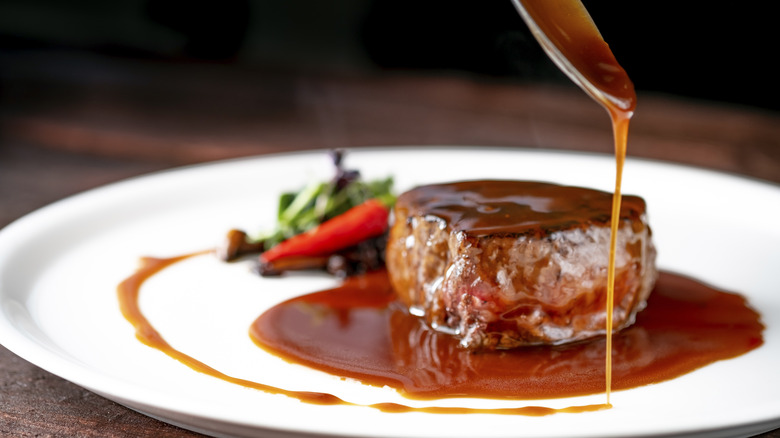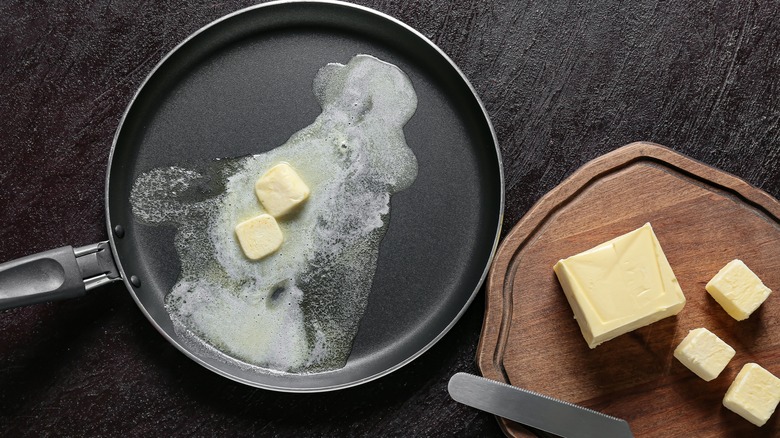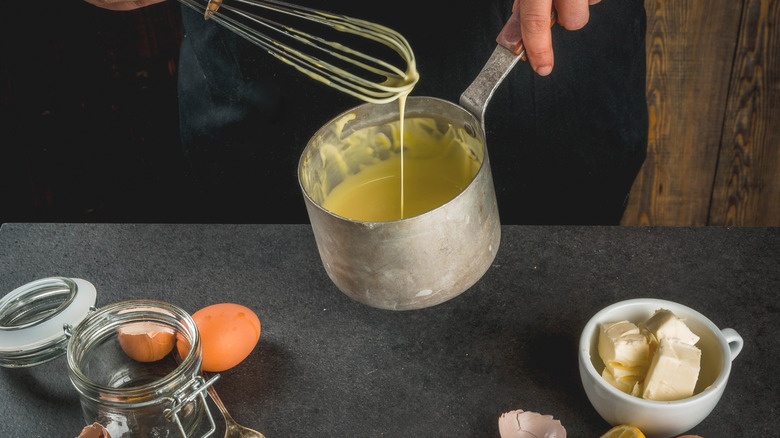Monter Au Beurre: The Method You Need For Elevating Pan Sauces
We may receive a commission on purchases made from links.
Monter (mon-TAY); why does that sound familiar? If you watched The Bear on Hulu, maybe you caught something. As Carmine was explaining how to make his recipe to his chefs, he said a French word and then quickly corrected himself. None of these chefs (save Sydney) are classically trained, so he pivoted to explaining the action: to finish the sauce with cubes of cold butter.
Doing this not only adds a beautiful glossy shine to your sauce, but it also builds a rich, decadent, satisfying mouth feel. It's the difference between a thin, watery pan sauce and a sauce with a lush body. It's the difference between sharp, almost unpleasant acidic flavors and a delicious, balanced finish to your dish. It's the difference between knowing what you're doing and, well, not.
And it's easy: cut cold butter into cubes. Take your pan sauce off the heat. Whisk, stir, or whirl one cube at a time in, allowing it to melt completely before adding the next. That's it.
Why temperature is so important
As a substance, butter is kind of fascinating (for example, it's a non-newtonian fluid). The phase state of butter is critical to success in many recipes. For flaky doughs like pie crusts and croissants, the butter must be very cold, very solid, and must stay very cold and solid until it hits the oven in order to produce layers. For many cakes and cookies, the butter has to be at room temperature to allow for sugar crystals to aerate and fluff it. Melted butter lends a denseness to baked goods. And if you use the wrong temperature for any of these, your recipe won't come out the right way.
When it comes to mounting, it's all about emulsification and balance. As we learn from Cook's Country, butter is water and fat bound by a phospholipid — and delicately, at that. Introducing butter to liquid, like that in a pan sauce, disrupts this balance and causes the emulsification to destabilize. With heat energizing the particles, this happens too rapidly for the butter to emulsify into the sauce. This creates an unappetizing oil slick floating on top of your pan sauce, rather than the luscious sauce you were hoping for. The ideal temperature range for this process to melt the butter into the sauce but not break above 85 degrees Fahrenheit (per Cook's Illustrated) but under 180 degrees Fahrenheit (per MasterClass). Adding cold chunks of butter slowly and off the heat helps stabilize the temperature.
Monter your sauces, savory and sweet
The typical usage of the monter au beurre process is in a savory pan sauce. When making a steak with a demi-glace sauce, you take advantage of the fond from searing the steaks, softening aromatics, and deglazing with Madeira and demi-glace. This will be too salty and acidic without a quick monter au beurre; by adding in that cold butter, you'll bring the sauce together for a worthy accompaniment to your steak. Next time you're making a gravy, whether it's Thanksgiving or not, try mounting the sauce with butter at the end. It will thicken the sauce to a rich glossiness, rather than an over-starched clumpiness.
More of a baker than a cook? As we see in this video from professional chef Avery Raassen, it's not only for savory pan sauces. By finishing his caramel sauce with this method, it balances the bitterness of the caramel, adds richness, and creates a beautiful shine. Pastry cream uses the same method: adding in cold butter off the heat introduces a glassy shine, richness, and balance, just like it does in pan sauces.


